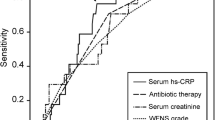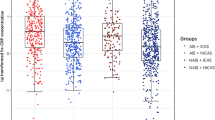Abstract
The objective of this study is to explore the relationship between the hypersensitive c-reactive protein (hs-CRP) level and the prognosis of acute brainstem infarction. Serum levels of hs-CRP were measured in 68 patients with acute brainstem infarction 72 h after disease onset. The hs-CRP levels in the U.S. National Institutes of Health Stroke Scale (NIHSS) score group and in the modified RANKIN scale (mRS) score group were compared. The independent risk factors of brainstem infarction were analyzed using Logistic binary regression. The hs-CRP level was significantly higher in the group with NIHSS >5 compared with the one with NIHSS ≤5 (P = 0.004). In the group with mRS > 2, the age, smoking history, and blood glucose level were significantly higher than those in the group with mRS ≤ 2 (P < 0.05), whereas the hs-CRP level was significantly higher (P = 0.001). Age and hs-CRP level were the independent prognostic factors of the brainstem infarction. The serum hs-CRP level is closely related with the severity and prognosis of brainstem infarction, and is an independent risk factor of acute brainstem infarction.
Similar content being viewed by others
References
Wang, W., & Che, Y. Q. (2010). Analysis of the clinical features of brainstem infarction. Chinese Journal of Hemorheology, 20(3), 385–387.
Gao, F., & He, S. M. (2005). Prognosis of brainstem infarction. Chinese Journal of Contemporary Neurology and Neurosurgery, 5, 352–354.
Boulman, N., Levy, Y., Leiba, R., Shachar, S., Linn, R., Zinder, O., & Blumenfeld, Z. (2004). Increased c-reactive protein levels in the polycystic ovary syndrome: A marker of cardiovascular disease. Journal of Clinical Endocrinology and Metabolism, 89, 2160.
Ross, R. (1999). Atherosclerosis-an inflammatory disease. New England Journal of Medicine, 340(24), 115–126.
Savitz, S. I., & Caplan, L. R. (2005). Vertebrobasilar disease. New England Journal of Medicine, 352, 2618–2626.
Lee, J. H., Han, S. J., Yun, Y. H., Choi, H. C., Jung, S., Cho, S. J., et al. (2006). Posterior circulation ischemic stroke in Korean population. European Journal of Neurology, 13(7), 742–748.
Koch, S., Amir, M., Rabinstein, A., Reyes-Iglesias, Y., Romano, J. G., & Forteza, A. (2005). Diffusion-weighted magnetic resonance imaging in symptomatic vertebrobasilar atherosclerosis and dissection. Archives of Neurology, 62(8), 1228–1231.
Dong, Y. H., Ji, Y. H., & Han, X. M. (2009). Difference between left and right hemispheric ischemic stroke. Journal of Practice Medical, 25(9), 1398–1400.
Heinrich, J., Schulte, H., Schonfeld, R., Köhler, E., & Assmann, G. (1995). Association of variables of coagulation, fibrinolysis and acute-phase with atherosclerosis in coronary and peripheral arteries and those arteries supplying the brain. Thrombosis and Haemostasis, 73(3), 374–379.
Castillo, J. (1999). Deteriorating stroke: Diagnosis criteria, predictors, mechanisms and treatment. Cerebrovascular Diseases, 9, 1–8.
Kameyamai, M., Fushmi, H., & Udaka, F. (1994). Diabetes mellitus and cerebral vascular disease. Diabetes Research and Clinical Practice, 24(Suppl), S205–S208.
Iwase, M., Yamamoto, M., Yoshinari, M., Ibayashi, S., & Fujishima, M. (1998). Stroke topography in diabetic and nondiabetic patients by magnetic resonance imaging. Diabetes Research and Clinical Practice, 42(2), 109–116.
Author information
Authors and Affiliations
Corresponding author
Rights and permissions
About this article
Cite this article
Zhang, X., Huang, WJ. & Yu, ZG. Relationship Between the Hypersensitive c-Reactive Protein (hs-CRP) Level and the Prognosis of Acute Brainstem Infarction. Cell Biochem Biophys 72, 107–110 (2015). https://doi.org/10.1007/s12013-014-0414-6
Published:
Issue Date:
DOI: https://doi.org/10.1007/s12013-014-0414-6




